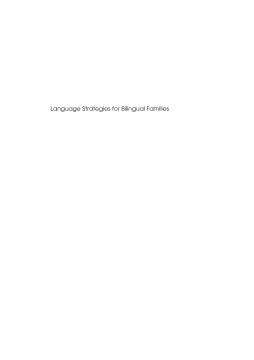
Additional Information
Book Details
Abstract
Lots of new parents these days have the opportunity to bring up their child with two or more languages because of increasing job mobility and the global community. The benefits of bilingualism and biculturalism such as higher cognitive skills, an awareness of language and sensitivity to other cultures, are being increasingly recognised. However many parents don’t know how to start, what methods to use or where to seek help when facing problems.
Now Suzanne Barron-Hauwaert, a mother of three trilingual children, teacher and linguist who has lived and worked all over the world, has written a book which provides an inspiring approach to passing on two or more languages to your children. In Language Strategies for Bilingual Families she considers several methods of bilingualism and focuses on the one-person one-language approach, in which each parent speaks his or her native language and is responsible for passing on his or her culture.
Suzanne questioned over a hundred bilingual families about their experiences and she interviewed thirty families in depth. The results of her study are linked to current academic research, but the book is both readable and relevant to non-academics and provides fascinating insights into being a multilingual family. It will prove an exciting and stimulating read for potential and current mixed-language families.
This book provides an excellent framework for parents who are interested in and concerned by raising bilingual children.
Dr. Beate Luo, Linguistlist
Suzanne has written a superbly clear and accessible account of the daily challenges of family life with several languages. Her recommendations are substantiated by extensive research and show great insight into children's language development. I particularly enjoyed the numerous case-studies of multilingual families, and I would warmly recommend this book as the 21st Century guide to parents of multilingual children.
Helen Le Merle
The book presents a well-developed and well-documented position on the OPOL approach.
Irma M. Olmedo, University of Illinois
Suzanne Barron-Hauwaert is on the Editorial Board of the Bilingual Family Newsletter. Married to a Frenchman with three young children she has direct experience of bringing up children with two or three languages. They have lived as an expatriate family in Hungry, Egypt and Switzerland. Suzanne trained as a teacher of English as a second language and taught adults and children in Japan and Poland. In 1999 she completed a Master's dissertation on trilingual families and continues to research bilingual and trilingual families.
Table of Contents
| Section Title | Page | Action | Price |
|---|---|---|---|
| Contents | v | ||
| Introduction | ix | ||
| Chapter 1 The One-Parent-One-Language Approach. What is it? | 1 | ||
| Chapter 2 The First Three Years and Establishing the One-Parent-One-Language Approach | 23 | ||
| Chapter 3 Starting School and Becoming Bicultural – One-Culture-One-Person? | 47 | ||
| Chapter 4 Interaction Between Family Members and the One-Person-One-Language Approach | 77 | ||
| Chapter 5 One-Parent-One-Language Families – Expectations and the Reality | 109 | ||
| Chapter 6 Living With Three or More Languages . . . One-Parent-Two-Languages (or More) | 138 | ||
| Chapter 7 Seven Strategies for Language Use Within the Family | 163 | ||
| Chapter 8 The One-Parent-One-Language Approach in the Twenty-First Century | 192 | ||
| Appendix 1: Studies on Bilingual Children | 198 | ||
| Appendix 2: The 2001 OPOL Questionaire | 201 | ||
| Appendix 3: Parent’s Nationalities and Country of Residence | 205 | ||
| Appendix 4: Case Study Families List | 207 | ||
| Sources of Information for Bilingual Families | 209 | ||
| Glossary | 211 | ||
| References | 215 | ||
| Index | 219 |
